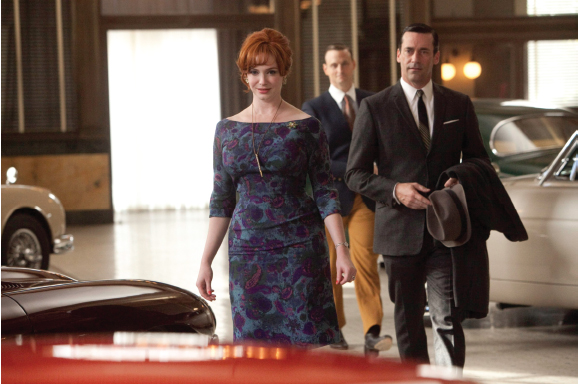The Influence of Visual Design

AMC’s hit series Mad Men depicts the male-dominated world of Madison Avenue in the 1960s, as the U.S. consumer economy kicked into high gear and agencies developed ad campaigns for cigarettes, exercise belts, and presidential candidates. In 2012, the show was nominated for seventeen Emmys and won Outstanding Drama Series for the fourth straight year in 2011.
Just as a postmodern design phase developed in art and architecture during the 1960s and 1970s, a new design era began to affect advertising at the same time. Part of this visual revolution was imported from non-U.S. schools of design; indeed, ad-rich magazines such as Vogue and Vanity Fair increasingly hired European designers as art directors. These directors tended to be less tied to U.S. word-driven radio advertising because most European countries had government-sponsored radio systems with no ads.
By the early 1970s, agencies had developed teams of writers and artists, thus granting equal status to images and words in the creative process. By the mid-1980s, the visual techniques of MTV, which initially modeled its style on advertising, influenced many ads and most agencies. MTV promoted a particular visual aesthetic—rapid edits, creative camera angles, compressed narratives, and staged performances. Video-style ads soon saturated television and featured such prominent performers as Paula Abdul, Ray Charles, Michael Jackson, Elton John, and Madonna. The popularity of MTV’s visual style also started a trend in the 1980s to license hit songs for commercial tie-ins. By the twenty-first century, a wide range of short, polished musical performances and familiar songs—including the work of Train (Samsung), the Shins (McDonald’s), LMFAO (Kia Motors), and classic Louis Armstrong (Apple iPhone)—were routinely used in TV ads to encourage consumers not to click the remote control.
“The combination of Omnicom Group of the U.S. and France’s Publicis Groupe SA is aimed at restoring the balance of power between advertising agencies and such Silicon Valley companies as Google Inc. and Facebook Inc.”
WALL STREET JOURNAL, 2013
Most recently, the Internet and multimedia devices, such as computers, mobile phones, and portable media players, have had a significant impact on visual design in advertising. As the Web became a mass medium in the 1990s, TV and print designs often mimicked the drop-down menu of computer interfaces. In the twenty-first century, visual design has evolved in other ways, becoming more three-dimensional and interactive, as full-motion, 3-D animation becomes a high-bandwidth multimedia standard. At the same time, design is also simpler, as ads and logos need to appear clearly on the small screens of smartphones and portable media players, and more international, as agencies need to appeal to the global audiences of many companies and therefore need to reflect styles from around the world.